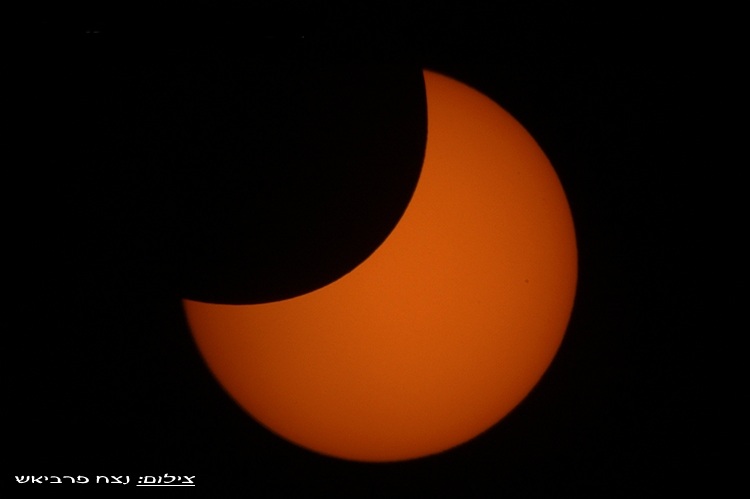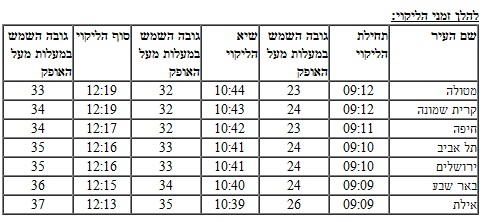For an observer from Israel, the moon will cover about 46% of the sun's surface. Another solar eclipse will not be visible from Israel until the end of 2013. This is the first of four eclipses that will occur this year - all partial

Update, the time is 17:00. Tonight in the next update of the site we will bring pictures of the eclipse as taken from the Ilan Ramon Center in Be'er Sheva, one of the few places in Israel where it was possible to watch the eclipse in the absence of clouds.
Update, 4/1/2011 – Observations
Observation updates: The Astronomical Club of Tel Aviv University will conduct an observation between the hours of 09:30 and 11:30 in the plaza of the Shenkar Physics building.
The Rakat observatory will broadcast the eclipse bhis website.
A partial solar eclipse will be visible in Israel on January 4.1.2011, 46. For an observer from Israel, the moon will cover about 2013% of the sun's surface. Another solar eclipse will not be visible from Israel until the end of XNUMX.
The eclipse will not be full at any of its points, as the cone of the moon's shadow will slightly miss the Earth's north pole and will not fall on the ground. The partial eclipse will be visible from all of Europe except the western parts of the British Isles, the northern part of Africa, Western Asia and the Middle East. The peak of the eclipse will be seen in Scandinavia where the maximum size of the eclipse that will be seen is 85.72% at 10:54:34 Israel time. The eclipse will be visible at sunrise on the northwest coast of Africa and end at sunset from central Russia and central Asia.
The Israeli Astronomical Society will broadcast the eclipse live on the website.
A solar eclipse occurs when the Moon is between the Sun and the Earth. In a total eclipse, the center of the Sun, the Moon and the Earth are almost on the same plane, but in a partial eclipse the Moon passes above or below the milky plane in such a way that it does not cover the entire solar disk. In the current eclipse, the moon passes north of the Milka plane, so the peak of the eclipse will be seen in the northern part of the Earth.
Observing a solar eclipse As a rule, it is strictly forbidden to look at the sun. Any use of improvised aids such as sooty glasses and the like is dangerous to the eye.
This is the first of four solar eclipses that will take place this year, except that they will all be partial.

The solar eclipse of January 4, 2011 - Amir Burnett
A solar eclipse occurs when the Sun is partially or fully obscured by the Moon. In order for an eclipse of this type to occur, the moon needs to pass between the earth and the sun, and its orbit must not pass above or below the line connecting the earth and the sun - for this reason, we do not see an eclipse every month. During a total eclipse, the blue daytime sky changes for a few minutes to a black sky and you can even see planets. In the eclipse parts of the sky remain blue and it is still dangerous to look at the sun with an unequipped eye just like any other day.
Observing the solar eclipse allows us to feel in real time the astronomical movement of celestial bodies, something that is usually not felt to such an extent. There are many ways to view the eclipse, but it is extremely important not to look directly at the sun without using appropriate equipment. Unprotected viewing of the sun can cause partial and temporary or even full and permanent blindness.
There are two easy and convenient ways to view the sun safely, one is by blocking most of the sun's intensity, for example with eclipse glasses, and the other by projecting the eclipse, for example, through simple binoculars. It is important to emphasize that you should not look at the sun with an unprotected eye!
At the Ilan Ramon Center, three different types of filters are used for viewing the sun, eclipse glasses made of black polymer that block 99.999% of visible light and an even larger part of the infrared and ultraviolet radiation, from the same material there are also special filters suitable for use on the portable ETX telescopes -125, Coronado's unique PST type sun viewing telescopes. In this telescope, an interferometer is installed, a device that allows the passage of a very narrow frequency range, that is, only a very small range of the entire color spectrum is able to pass. the sun
A very simple way to watch the eclipse anywhere is with the help of a camera obscura, a small hole allows light to pass through to a screen on which you see the projection of the sun. In the same way, if you have a tray at home (a frying pan) with round holes, try to shine the sunlight through it, if there is a tree near you that hides most of the sun, but not completely, you can see that the shadows have a special shape at this time.
If you want to see a little more detail, but with the help of means available in every home, you can create an upgraded camera obscura, instead of a small hole that will transmit the light, you can put an optical device that will enlarge the figure - a telescope or binoculars. Of course, you must not look at the sun through these devices, but you can project their light onto a sheet of paper (for example baking paper) and see the sun shining on it. You should not use the most expensive binoculars you found, nor a telescope that includes aiming mirrors because the intensity of the sun that will be projected onto them can damage these optical assemblies.
When should you watch the eclipse? You can check with a software such as Stellarium when the eclipse is supposed to start, if you calibrate your watches to an exact time and wait for the eclipse to start or end you can check how accurate this software is, I personally think that these are also the most interesting moments to watch the eclipse and not necessarily at the "peak" time when it shows The Moon on the Sun is quite static.
The Ilan Ramon Center for Youth Seeking Physics is preparing to hold a number of sessions that day for students and the general public. We would be happy if you could publish information about the activities we will hold. Students who participate in the scientific leadership program will make observations and explain about the eclipse at their school, a telescope complex will be set up at Ben Gurion University where it will be possible to observe the eclipse through different types of telescopes and receive explanations on the subject. At the Ilan Ramon Center for Youth Seeking Physics, observations will be made as part of high school students' matriculation projects and photos of the eclipse will be uploaded in almost real time. All these activities are conditional on the existence of good weather.
*It is important to remember that the weather may not take us into account and clouds will arrive, we will hope for rain in the days before and after, but not on Tuesday morning.

6 תגובות
What a powerful game
The next total solar eclipse will be visible from Israel (if I'm not mistaken) in 2124. There is something to wait for.
As far as I knew, there was a full moon eclipse on 15-06-2011
Does anyone know when we will finally get to see a full eclipse in our tiny country?
Knows what..
Here are all 15 episodes to watch, each episode a different topic
http://www.youtube.com/show/cosmicjourneys?s=1
my father
A gift for you and yours
Spectacular video on black holes
* Choose the highest resolution (as far as the internet connection allows), and press full screen,
and enjoy
http://www.youtube.com/watch?v=D3AfNXdg2Tk